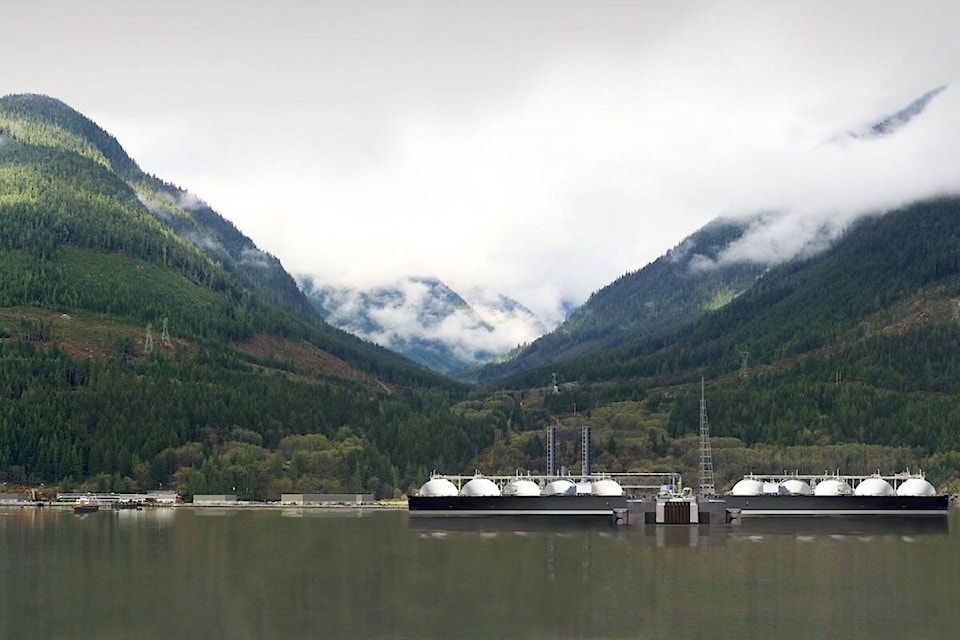By: Radha Agarwal
Three years out from the expected opening of an LNG export facility in Squamish, scientists are studying what health impacts air pollution from the site could have on people living nearby.
The Woodfibre LNG facility in question is currently under construction and set to open in 2027. The study of the facility’s consequences began in March.
Dr. Laura Minet, lead researcher and head of the Clean Air lab at the University of Victoria, said the study is timely with a total of eight new LNG export facilities approved in Canada — six of them planned in B.C.
“We’ve decided to take Woodfibre LNG as a test case as it is set to open next in B.C.,” Minet said.
The study will look at flaring, the practice of burning off excess natural gas that builds up during the production of liquefied natural gas (LNG) or during unexpected events. That flaring can release toxic gases into the atmosphere and lead to problems such as acid rain and greenhouse gases.
Minet pointed out that flaring can impact air quality and could harm the health of people living nearby.
“I’m not saying it will happen for sure, but as a scientist it is fair to consider the non-ideal scenarios,” she said.
Squamish is projected to have a population of 8,000 residents by 2025. They’ll fall in close proximity to where the proposed Woodfibre LNG export facility will be built.
The Pembina Institute, in a report looking at LNG expansion in B.C., found that if all six proposed facilities are built in B.C., they will emit as much carbon pollution as if the province were burning 34 billion pounds of coal every year. That pollution will affect the residents of communities like Squamish.
Minet is collaborating with several other scientists and professors from UVic, Vancouver Coastal Health, the Canadian Association of Physicians for the Environment (CAPE), Simon Fraser University, the University of Toronto, Texas AM University and the non-profit My Sea to Sky. The project is funded by the federal government and the Natural Sciences and Engineering Research Council of Canada.
Minet said they will access information from existing LNG facilities in the world for the past decade, like those in Australia, the U.S. and Norway. They will also use satellite data, specifically from software that determines the amount of flaring generated by different facilities. With that information, the scientists will develop scenarios for flaring for the first year or two of operation at the Squamish facility.
The research team will look at both normal scenarios and abnormal ones that occur during facility maintenance to understand the impacts on nearby residents.
Minet noted scientists now have more information about the real-world implications of LNG facilities than they did when environmental compliance certificates were issued five or 10 years ago. In many cases, she said, existing LNG facilities have flared more than was originally predicted.
Tim Takaro, a CAPE BC member and expert on toxicology and public health, said the new data in the study will provide an “invaluable contribution” to current discussions. He said scientists recently found that measurements used by industry in Alberta’s tar sands were under-reporting air pollution emissions by anywhere from 1,900 to more than 6,300 per cent.
READ ALSO: Doctors, nurses want B.C. to limit wildfire, climate impacts of LNG industry
Minet cautioned that, although the Woodfibre LNG facility is being marketed as “net zero,” that doesn’t mean it will produce no emissions.
“When they say net zero, it’s not zero carbon emissions. So they talk about greenhouse gasses. And greenhouse gases are different from air pollutants. So they can claim to be zero, meaning that the balance of carbon emissions in terms of the carbon they emit and how many credits they get in terms of carbon emissions can be zero.
But that doesn’t mean that there’s no air pollutant emissions, because of emissions of carbon monoxide, nitrogen oxides, particulate matter, or voluntary organic compounds, none of this comes into the equation for the calculation of carbon emissions,” says Dr. Minet.
The upcoming Woodfibre LNG facility in Squamish is privately owned by Woodfibre LNG Limited Partnership, Pacific Energy Corporation (Canada) Limited and Enbridge Inc.
READ ALSO: Squamish LNG facility plans to achieve net-zero emissions at operation’s start
READ ALSO: Watchdogs critical of B.C.’s continued support of LNG ‘carbon bomb’
